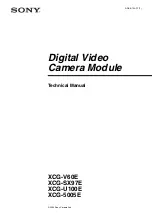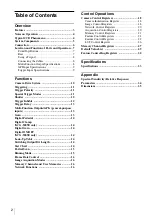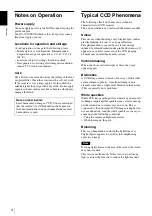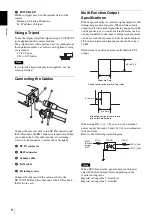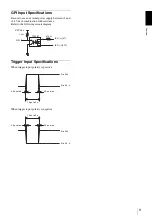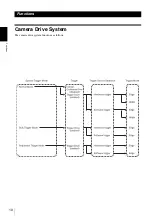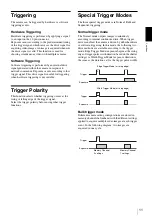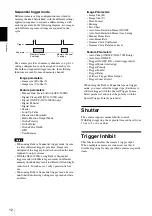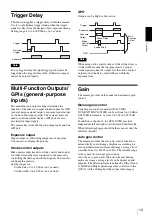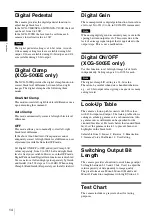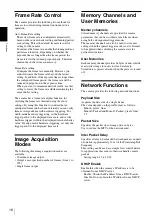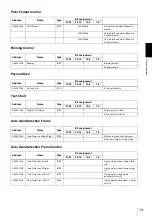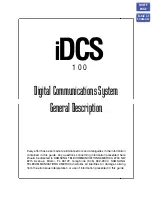
Ov
e
rvi
ew
4
Notes on Operation
Power supply
You can supply power via the DC IN connector using the
power adapter.
Use DC-700/700CE which is the stable power source
free from ripple or noise.
Locations for operation and storage
Avoid operation or storage in the following places.
• Extremely hot or cold locations. Recommended
temperature range for operation is 0 to 40 °C (32 to
104 °F).
• Locations subject to strong vibration or shock.
• Near generators of strong electromagnetic radiation
such as TV or radio transmitters.
Care
Use a blower to remove dust from the surface of the lens
or optical filter. Clean the exterior with a soft, dry cloth.
If the camera is very grimy, apply a cloth soaked in a
mild detergent then wipe with a dry cloth. Do not apply
organic solvents such as alcohol or benzine which may
damage the finish.
Typical CCD Phenomena
The following effects on the monitor screen are
characteristic of CCD cameras.
They do not indicate any fault with the camera module.
Smear
This occurs when shooting a very bright object such as
electric lighting, the sun, or a strong reflection.
This phenomenon is caused by an electric charge
induced by infrared radiation deep in the photosensor. It
appears as a vertical smear, since the CCD imaging
element uses an interline transfer system.
Vertical aliasing
When you shoot vertical stripes or lines, they may
appear jagged.
Blemishes
A CCD image sensor consists of an array of individual
sensor elements (pixels). A malfunctioning sensor
element will cause a single pixel blemish in the picture.
(This is generally not a problem.)
White speckles
While CCD image pickup device is made by an accurate
technique, imperceptible speckless may rarely come up
on the screen due to cosmic rays and so on. This is
connected to the principle of CCD image pickup device,
not a malfunction. And the white speckless are easy to
come up in the following conditions.
• Using the camera in high temperature
• When turning up the gain
Blooming
This is a phenomenon in which the light from very
bright objects appears to overflow into neighboring
areas in an image.
Note
If strong light enters a wide area of the screen, the screen
may become dark.
This is not a malfunction. If this occurs, avoid strong
light or adjust the lens iris to reduce the light amount.
Note on laser beams
Laser beams may damage a CCD. You are cautioned
that the surface of a CCD should not be exposed to
laser beam radiation in an environment where a laser
beam device is used.

